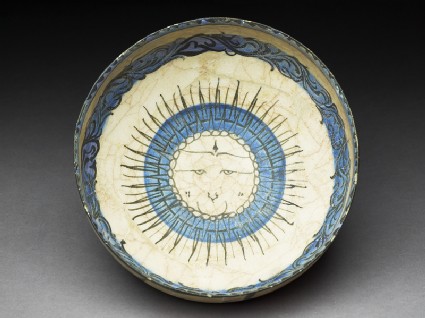Search Results: objects
Show search help- Reference URL
Actions
Bowl with central sun
-
Details
- Associated place
- Date
- early 13th century
- Material and technique
- fritware, with underglaze painting in blue and black
- Dimensions
-
10.5 cm (height)
19.3 cm (diameter)
at foot 7.6 cm (diameter)
- Material index
- Technique index
- Object type index
- No. of items
- 1
- Credit line
- Gift of Gerald Reitlinger, 1978.
- Accession no.
- EA1978.2311
-
Further reading
Allan, James W., Islamic Ceramics, Ashmolean-Christie's Handbooks (Oxford: Ashmolean Museum, 1991), no. 10 on p. 22, illus. p. 23
Glossary (2)
fritware, underglaze painting
-
fritware
Ceramic material composed of ground quartz and small quantities of clay and finely ground frit (frit is obtained by pouring molten glass into water).
-
underglaze painting
Painting applied to ceramic material before a transparent, or monochrome or coloured glaze for Islamic objects, is applied. The technique was initially developed in China.
Location
-
- currently in research collection
Objects are sometimes moved to a different location. Our object location data is usually updated on a monthly basis. Contact the Jameel Study Centre if you are planning to visit the museum to see a particular object on display, or would like to arrange an appointment to see an object in our reserve collections.
Publications online
-

Islamic Ceramics
Painting in blue and black under the glaze was a technique developed round about 1200 AD in Iran. The immediate precursor of the techniques seems to have been painting in black slip under a clear or transparent turquoise glaze, the so-called ‘silhouette ware’ (see no.9 [EA1956.130]). The thickness of the slip and the carving technique employed in the latter wares lent itself to broad, boldly-conceived designs, but was unsuitable for more precise painting and for all the sorts of designs which were becoming more popular in illustrated manuscripts. In order to meet this challenge the potters first developed underglaze-painting, and later overglaze painting (see nos. 13-14 [EAX.1302 & EA1956.36]). In underglaze-painting the blue derives from cobalt oxide, and the black from a mineral containing iron, manganese and chrome mined near Kashan in western Iran. The important discovery of the potters was that both these pigments are relatively stable under an alkaline glaze.
The design on this bowl shows the way the blue and black were normally used, the blue for broader bands, the black for detailed work. Here the central motif is the face of the Sun. Medieval Islamic society took astrology very seriously, and numerous objects were decorated with the Sun and other planets, or with the signs of the zodiac (see no. 16 [EA1956.58]). In contemporary metalwork, where more elaborate designs were laboriously worked out in silver and copper inlays, the Sun is normally surrounded by the other six known planets, the Moon, Mercury, Venus, Mars, Jupiter, and Saturn. In ceramics the tendency in decorating was always towards a shorthand, and here the Sun is probably meant to bring to mind the whole of the heavens and the good fortune which might thereby accrue to the owner of the bowl.
© 2013 University of Oxford - Ashmolean Museum


